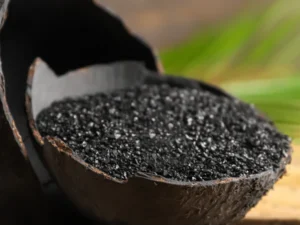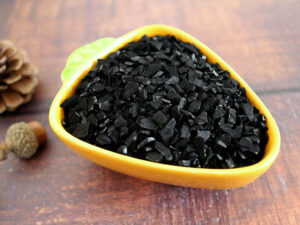Description
Activated Carbon: The Unsung Hero of Clean Water
In a world increasingly aware of water quality, one often-underappreciated material plays a critical role in ensuring our tap water is safe and palatable: activated carbon. From industrial wastewater treatment to home water filters, this versatile substance stands as a powerful tool in the fight against waterborne contaminants.
But what exactly is activated carbon, and why is it so effective at cleaning water?
The Secret Lies in the Surface Area:
Activated carbon, also known as activated charcoal, isn’t just ordinary charcoal. It’s processed to have a massively increased surface area. Imagine taking a single teaspoon of activated carbon – its surface area could be equivalent to an entire football field! This extreme porosity is achieved through various methods like steam activation or chemical activation, creating countless tiny pores and crevices on the carbon’s surface.
How Activated Carbon Treats Water: Adsorption in Action
The phenomenal surface area of activated carbon allows it to work through a process called adsorption. This is different from absorption, where a substance is soaked up like a sponge. Instead, adsorption involves contaminants sticking to the surface of the activated carbon. Think of it like a magnet attracting metal shavings.
This adsorption process is highly effective at removing a wide range of pollutants, including:
- Organic compounds: These include chlorine, pesticides, herbicides, and volatile organic compounds (VOCs), which can affect taste, odor, and potentially pose health risks.
- Disinfection byproducts (DBPs): Formed when chlorine reacts with organic matter in water, DBPs like trihalomethanes (THMs) are known carcinogens.
- Industrial chemicals: Activated carbon can remove various industrial pollutants that may contaminate water sources near manufacturing plants.
- Taste and odor-causing compounds: Even if water is technically safe to drink, unpleasant tastes and odors can make it unpalatable. Activated carbon helps remove these compounds, improving the aesthetic quality of water.
- Certain heavy metals: While not as effective as specialized ion exchange resins, activated carbon can help reduce the concentration of some heavy metals in water.
Different Forms for Different Needs:
Activated carbon comes in various forms, each tailored to specific applications:
- Granular Activated Carbon (GAC): This is the most common form, found in pitchers, faucet filters, and point-of-use (POU) systems. Its granular structure allows for efficient water flow and good pressure.
- Powdered Activated Carbon (PAC): This fine powder is often used in large-scale municipal water treatment plants, added directly to the water and then filtered out later.
- Block Activated Carbon: Compressed into solid blocks, this form offers better performance than GAC in removing certain contaminants due to its higher density and increased contact time.
Advantages and Limitations:
Activated carbon offers several advantages for water treatment:
- Cost-effective: Compared to other advanced treatment technologies, activated carbon is relatively affordable.
- Effective against a broad range of contaminants: Its versatility makes it a valuable tool for tackling diverse water quality issues.
- Easy to use: Simple implementation in various filter systems.
- Improves taste and odor: Makes water more palatable and enjoyable to drink.
However, it’s important to be aware of its limitations:
- Does not remove all contaminants: It’s not effective against dissolved inorganic substances like minerals, salts, and fluoride.
- Requires regular replacement: Once its surface area is saturated with contaminants, the carbon needs to be replaced to maintain its effectiveness.
- Potential for bacterial growth: If not properly maintained, activated carbon can become a breeding ground for bacteria, which can then leach into the water. This is why regular filter replacement is crucial.
The Future of Activated Carbon in Water Treatment:
As water scarcity and pollution become increasingly pressing issues, activated carbon will continue to play a vital role in providing safe and clean water. Ongoing research focuses on developing even more efficient and sustainable activated carbon materials, potentially derived from renewable resources like agricultural byproducts or biomass.
In Conclusion:
Activated carbon is a powerful and versatile tool for improving water quality. From removing unwanted tastes and odors to tackling harmful pollutants, this unsung hero of clean water ensures that we have access to safe and palatable drinking water. By understanding how it works and recognizing its limitations, we can appreciate its crucial role in protecting our health and the environment. So, the next time you take a sip of fresh, clean water, remember the tiny, porous marvel that helped make it possible: activated carbon.














Reviews
There are no reviews yet.